This is a list of the bird species recorded in Afghanistan. The avifauna of Afghanistan include a total of 502 species, of which 4 have been introduced by humans. Of the species in Afghanistan, 25 species are globally threatened.
This list's taxonomic treatment (designation and sequence of orders, families and species) and nomenclature (common and scientific names) follow the conventions of The Clements Checklist of Birds of the World, 2022 edition. The family accounts at the beginning of each heading reflect this taxonomy, as do the species counts found in each family account. Introduced and accidental species are included in the total counts for Afghanistan.
The following tags have been used to highlight several categories. The commonly occurring native species do not fall into any of these categories.
- (A) Accidental - a species that rarely or accidentally occurs in Afghanistan
- (I) Introduced - a species introduced to Afghanistan as a consequence, direct or indirect, of human actions
Ducks, geese, and waterfowl
Order: Anseriformes Family: Anatidae
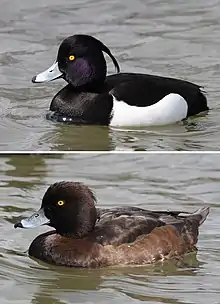
.jpg.webp)
Anatidae includes the ducks and most duck-like waterfowl, such as geese and swans. These birds are adapted to an aquatic existence with webbed feet, flattened bills, and feathers that are excellent at shedding water due to an oily coating.
- Bar-headed goose, Anser indicus
- Graylag goose, Anser anser
- Greater white-fronted goose, Anser albifrons
- Lesser white-fronted goose, Anser erythropus
- Red-breasted goose, Branta ruficollis
- Mute swan, Cygnus olor
- Whooper swan, Cygnus cygnus
- Ruddy shelduck, Tadorna ferruginea
- Common shelduck, Tadorna tadorna
- Cotton pygmy-goose, Nettapus coromandelianus
- Baikal teal, Sibirionetta formosa (A)
- Garganey, Spatula querquedula
- Northern shoveler, Spatula clypeata
- Gadwall, Mareca strepera
- Falcated duck, Mareca falcata (A)
- Eurasian wigeon, Mareca penelope
- Mallard, Anas platyrhynchos
- Northern pintail, Anas acuta
- Green-winged teal, Anas crecca
- Marbled teal, Marmaronetta angustirostris
- Red-crested pochard, Netta rufina
- Common pochard, Aythya ferina
- Ferruginous duck, Aythya nyroca
- Tufted duck, Aythya fuligula
- Greater scaup, Aythya marila
- Velvet scoter, Melanitta fusca (A)
- Common goldeneye, Bucephala clangula
- Smew, Mergellus albellus
- Common merganser, Mergus merganser
- Red-breasted merganser, Mergus serrator (A)
- White-headed duck, Oxyura leucocephala
Pheasants, grouse, and allies
Order: Galliformes Family: Phasianidae
_(48445413157).jpg.webp)
The Phasianidae are a family of terrestrial birds. In general, they are plump (although they vary in size) and have broad, relatively short wings.
- See-see partridge, Ammoperdix griseogularis
- Common quail, Coturnix coturnix
- Chukar, Alectoris chukar
- Tibetan snowcock, Tetraogallus tibetanus
- Himalayan snowcock, Tetraogallus himalayensis
- Black francolin, Francolinus francolinus
- Gray francolin, Ortygornis pondicerianus
- Himalayan monal, Lophophorus impejanus
- Ring-necked pheasant, Phasianus colchicus
- Cheer pheasant, Catreus wallichii
- Gray partridge, Perdix perdix
- Koklass pheasant, Pucrasia macrolopha
Flamingos
Order: Phoenicopteriformes Family: Phoenicopteridae
Flamingos are gregarious wading birds, usually 3 to 5 feet (0.9 to 1.5 m) tall, found in both the Western and Eastern Hemispheres. Flamingos filter-feed on shellfish and algae. Their oddly shaped beaks are specially adapted to separate mud and silt from the food they consume and, uniquely, are used upside-down.
- Greater flamingo, Phoenicopterus roseus
- Lesser flamingo, Phoenicopterus minor (A)
Grebes
Order: Podicipediformes Family: Podicipedidae
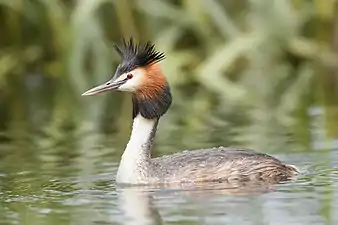
Grebes are small to medium-large freshwater diving birds. They have lobed toes and are excellent swimmers and divers. However, they have their feet placed far back on the body, making them quite ungainly on land.
- Little grebe, Tachybaptus ruficollis
- Red-necked grebe, Podiceps grisegena
- Great crested grebe, Podiceps cristatus
- Eared grebe, Podiceps nigricollis
Pigeons and doves
Order: Columbiformes Family: Columbidae
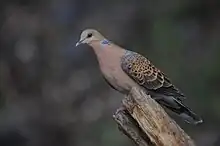
Pigeons and doves are stout-bodied birds with short necks and short slender bills with a fleshy cere.
- Rock pigeon, Columba livia
- Hill pigeon, Columba rupestris
- Snow pigeon, Columba leuconota
- Speckled pigeon, Columba guinea (I)
- Stock dove, Columba oenas (A)
- Yellow-eyed pigeon, Columba eversmanni
- Common wood-pigeon, Columba palumbus
- European turtle-dove, Streptopelia turtur
- Oriental turtle-dove, Streptopelia orientalis
- Eurasian collared-dove, Streptopelia decaocto
- Spotted dove, Spilopelia chinensis (A)
- Laughing dove, Spilopelia senegalensis
Sandgrouse
Order: Pterocliformes Family: Pteroclidae
_male%252C_Eilat._by_Lior_Kislev.jpg.webp)
Sandgrouse have small, pigeon like heads and necks, but sturdy compact bodies. They have long pointed wings and sometimes tails and a fast direct flight. Flocks fly to watering holes at dawn and dusk. Their legs are feathered down to the toes.
- Tibetan sandgrouse, Syrrhaptes tibetanus
- Pin-tailed sandgrouse, Pterocles alchata
- Spotted sandgrouse, Pterocles senegallus (A)
- Black-bellied sandgrouse, Pterocles orientalis
- Crowned sandgrouse, Pterocles coronatus
- Lichtenstein's sandgrouse, Pterocles lichtensteinii
Bustards
Order: Otidiformes Family: Otididae
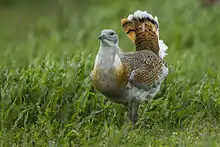
Bustards are large terrestrial birds mainly associated with dry open country and steppes in the Old World. They are omnivorous and nest on the ground. They walk steadily on strong legs and big toes, pecking for food as they go. They have long broad wings with "fingered" wingtips and striking patterns in flight. Many have interesting mating displays.
- Great bustard, Otis tarda
- Macqueen's bustard, Chlamydotis macqueenii
- Little bustard, Tetrax tetrax
Cuckoos
Order: Cuculiformes Family: Cuculidae
_11.jpg.webp)
The family Cuculidae includes cuckoos, roadrunners and anis. These birds are of variable size with slender bodies, long tails and strong legs.
- Pied cuckoo, Clamator jacobinus (A)
- Asian koel, Eudynamys scolopaceus
- Lesser cuckoo, Cuculus poliocephalus
- Common cuckoo, Cuculus canorus
Nightjars and allies
_01.jpg.webp)
Order: Caprimulgiformes Family: Caprimulgidae
Nightjars are medium-sized nocturnal birds that usually nest on the ground. They have long wings, short legs and very short bills. Most have small feet, of little use for walking, and long pointed wings. Their soft plumage is camouflaged to resemble bark or leaves.
- Eurasian nightjar, Caprimulgus europaeus
- Egyptian nightjar, Caprimulgus aegyptius
- Sykes's nightjar, Caprimulgus mahrattensis
- Indian nightjar, Caprimulgus asiaticus
Swifts

Order: Caprimulgiformes Family: Apodidae
Swifts are small birds which spend the majority of their lives flying. These birds have very short legs and never settle voluntarily on the ground, perching instead only on vertical surfaces. Many swifts have long swept-back wings which resemble a crescent or boomerang.
- White-throated needletail, Hirundapus caudacutus (A)
- Alpine swift, Apus melba
- Common swift, Apus apus
- Little swift, Apus affinis
Rails, gallinules and coots
_France.jpg.webp)
Order: Gruiformes Family: Rallidae
Rallidae is a large family of small to medium-sized birds which includes the rails, crakes, coots and gallinules. Typically they inhabit dense vegetation in damp environments near lakes, swamps or rivers. In general they are shy and secretive birds, making them difficult to observe. Most species have strong legs and long toes which are well adapted to soft uneven surfaces. They tend to have short, rounded wings and to be weak fliers.
- Water rail, Rallus aquaticus
- Corn crake, Crex crex
- Spotted crake, Porzana porzana
- Eurasian moorhen, Gallinula chloropus
- Eurasian coot, Fulica atra
- Gray-headed swamphen, Porphyrio poliocephalus
- Ruddy-breasted crake, Zapornia fusca (A)
- Little crake, Zapornia parva
- Baillon's crake, Zapornia pusilla
Cranes
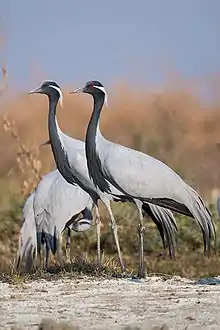
Order: Gruiformes Family: Gruidae
Cranes are large, long-legged and long-necked birds. Unlike the similar-looking but unrelated herons, cranes fly with necks outstretched, not pulled back. Most have elaborate and noisy courting displays or "dances".
- Demoiselle crane, Anthropoides virgo
- Siberian crane, Leucogeranus leucogeranus (A) (possibly extirpated)[1]
- Common crane, Grus grus
Thick-knees
Order: Charadriiformes Family: Burhinidae
The thick-knees are a group of largely tropical waders in the family Burhinidae. They are found worldwide within the tropical zone, with some species also breeding in temperate Europe and Australia. They are medium to large waders with strong black or yellow-black bills, large yellow eyes and cryptic plumage. Despite being classed as waders, most species have a preference for arid or semi-arid habitats.
- Eurasian thick-knee, Burhinus oedicnemus
Stilts and avocets
_2.jpg.webp)
Order: Charadriiformes Family: Recurvirostridae
Recurvirostridae is a family of large wading birds, which includes the avocets and stilts. The avocets have long legs and long up-curved bills. The stilts have extremely long legs and long, thin, straight bills.
- Black-winged stilt, Himantopus himantopus
- Pied avocet, Recurvirostra avosetta
Ibisbill
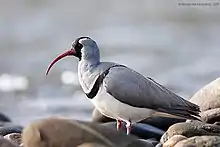
Order: Charadriiformes Family: Ibidorhynchidae
The ibisbill is related to the waders, but is sufficiently distinctive to be a family unto itself. The adult is gray with a white belly, red legs, a long down curved bill, and a black face and breast band.
- Ibisbill, Ibidorhyncha struthersii (A)
Oystercatchers
Order: Charadriiformes Family: Haematopodidae
The oystercatchers are large and noisy plover-like birds, with strong bills used for smashing or prising open molluscs.
- Eurasian oystercatcher, Haematopus ostralegus
Plovers and lapwings
.jpg.webp)
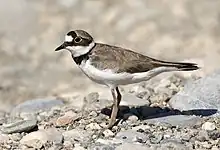
Order: Charadriiformes Family: Charadriidae
The family Charadriidae includes the plovers, dotterels and lapwings. They are small to medium-sized birds with compact bodies, short, thick necks and long, usually pointed, wings. They are found in open country worldwide, mostly in habitats near water.
- Black-bellied plover, Pluvialis squatarola
- Pacific golden-plover, Pluvialis fulva (A)
- Northern lapwing, Vanellus vanellus
- Red-wattled lapwing, Vanellus indicus
- Sociable lapwing, Vanellus gregarius
- White-tailed lapwing, Vanellus leucurus
- Lesser sand-plover, Charadrius mongolus
- Greater sand-plover, Charadrius leschenaultii
- Caspian plover, Charadrius asiaticus
- Kentish plover, Charadrius alexandrinus
- Common ringed plover, Charadrius hiaticula
- Little ringed plover, Charadrius dubius
Painted-snipes
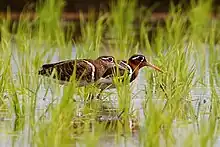
Order: Charadriiformes Family: Rostratulidae
Painted-snipes are short-legged, long-billed birds similar in shape to the true snipes, but more brightly coloured.
- Greater painted-snipe, Rostratula benghalensis
Jacanas
_juvenile.jpg.webp)
Order: Charadriiformes Family: Jacanidae
The jacanas are a group of tropical waders in the family Jacanidae. They are found throughout the tropics. They are identifiable by their huge feet and claws which enable them to walk on floating vegetation in the shallow lakes that are their preferred habitat.
- Pheasant-tailed jacana, Hydrophasianus chirurgus
Sandpipers and allies
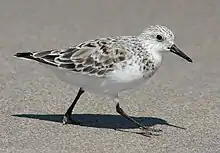
.jpg.webp)
Order: Charadriiformes Family: Scolopacidae
Scolopacidae is a large diverse family of small to medium-sized shorebirds including the sandpipers, curlews, godwits, shanks, tattlers, woodcocks, snipes, dowitchers and phalaropes. The majority of these species eat small invertebrates picked out of the mud or soil. Variation in length of legs and bills enables multiple species to feed in the same habitat, particularly on the coast, without direct competition for food. There are 27 species which have been recorded in Afghanistan.
- Whimbrel, Numenius phaeopus
- Far Eastern curlew, Numenius madagascariensis (A)
- Eurasian curlew, Numenius arquata
- Bar-tailed godwit, Limosa lapponica
- Black-tailed godwit, Limosa limosa
- Ruddy turnstone, Arenaria interpres
- Ruff, Calidris pugnax
- Broad-billed sandpiper, Calidris falcinellus (A)
- Curlew sandpiper, Calidris ferruginea
- Temminck's stint, Calidris temminckii
- Sanderling, Calidris alba
- Dunlin, Calidris alpina
- Little stint, Calidris minuta
- Jack snipe, Lymnocryptes minimus
- Eurasian woodcock, Scolopax rusticola
- Solitary snipe, Gallinago solitaria
- Common snipe, Gallinago gallinago
- Pin-tailed snipe, Gallinago stenura (A)
- Terek sandpiper, Xenus cinereus
- Red-necked phalarope, Phalaropus lobatus
- Common sandpiper, Actitis hypoleucos
- Green sandpiper, Tringa ochropus
- Spotted redshank, Tringa erythropus
- Common greenshank, Tringa nebularia
- Marsh sandpiper, Tringa stagnatilis (A)
- Wood sandpiper, Tringa glareola
- Common redshank, Tringa totanus
Pratincoles and coursers
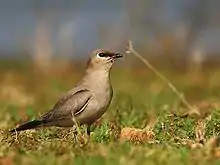
Order: Charadriiformes Family: Glareolidae
Glareolidae is a family of wading birds comprising the pratincoles, which have short legs, long pointed wings and long forked tails, and the coursers, which have long legs, short wings and long, pointed bills which curve downwards.
- Cream-colored courser, Cursorius cursor
- Collared pratincole, Glareola pratincola (A)
- Small pratincole, Glareola lactea (A)
Gulls, terns, and skimmers
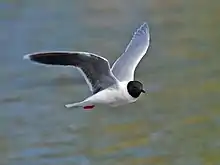
_(25737235335).jpg.webp)
Order: Charadriiformes Family: Laridae
Laridae is a family of medium to large seabirds, the gulls, terns, and skimmers. Gulls are typically grey or white, often with black markings on the head or wings. They have stout, longish bills and webbed feet. Terns are a group of generally medium to large seabirds typically with grey or white plumage, often with black markings on the head. Most terns hunt fish by diving but some pick insects off the surface of fresh water. Terns are generally long-lived birds, with several species known to live in excess of 30 years.
- Slender-billed gull, Chroicocephalus genei
- Black-headed gull, Chroicocephalus ridibundus
- Brown-headed gull, Chroicocephalus brunnicephalus (A)
- Little gull, Hydrocoloeus minutus (A)
- Pallas's gull, Ichthyaetus ichthyaetus
- Common gull, Larus canus (A)
- Lesser black-backed gull, Larus fuscus
- Little tern, Sternula albifrons
- Gull-billed tern, Gelochelidon nilotica
- Caspian tern, Hydroprogne caspia
- Black tern, Chlidonias niger (A)
- White-winged tern, Chlidonias leucopterus
- Whiskered tern, Chlidonias hybrida (A)
- Common tern, Sterna hirundo
- River tern, Sterna aurantia (A)
Storks
Order: Ciconiiformes Family: Ciconiidae
Storks are large, long-legged, long-necked, wading birds with long, stout bills. Storks are mute, but bill-clattering is an important mode of communication at the nest. Their nests can be large and may be reused for many years. Many species are migratory.
- Black stork, Ciconia nigra
- White stork, Ciconia ciconia
Cormorants and shags
_I_IMG_8092.jpg.webp)
Order: Suliformes Family: Phalacrocoracidae
Phalacrocoracidae is a family of medium to large coastal, fish-eating seabirds that includes cormorants and shags. Plumage colouration varies, with the majority having mainly dark plumage, some species being black-and-white and a few being colourful.
- Little cormorant, Microcarbo niger (A)
- Pygmy cormorant, Microcarbo pygmeus
- Great cormorant, Phalacrocorax carbo
- Indian cormorant, Phalacrocorax fuscicollis (A)
Pelicans
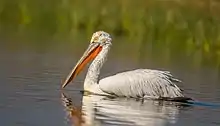
Order: Pelecaniformes Family: Pelecanidae
Pelicans are large water birds with a distinctive pouch under their beak. As with other members of the order Pelecaniformes, they have webbed feet with four toes.
- Great white pelican, Pelecanus onocrotalus
- Dalmatian pelican, Pelecanus crispus
Herons, egrets, and bitterns
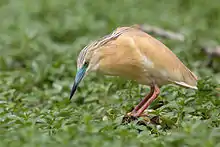
Order: Pelecaniformes Family: Ardeidae
The family Ardeidae contains the bitterns, herons and egrets. Herons and egrets are medium to large wading birds with long necks and legs. Bitterns tend to be shorter necked and more wary. Members of Ardeidae fly with their necks retracted, unlike other long-necked birds such as storks, ibises and spoonbills.
- Great bittern, Botaurus stellaris
- Little bittern, Ixobrychus minutus
- Cinnamon bittern, Ixobrychus cinnamomeus (A)
- Gray heron, Ardea cinerea
- Purple heron, Ardea purpurea
- Great egret, Ardea alba
- Little egret, Egretta garzetta (A)
- Cattle egret, Bubulcus ibis (A)
- Squacco heron, Ardeola ralloides (A)'
- Black-crowned night-heron, Nycticorax nycticorax
Ibises and spoonbills

Order: Pelecaniformes Family: Threskiornithidae
Threskiornithidae is a family of large terrestrial and wading birds which includes the ibises and spoonbills. They have long, broad wings with 11 primary and about 20 secondary feathers. They are strong fliers and despite their size and weight, very capable soarers.
- Glossy ibis, Plegadis falcinellus
- Eurasian spoonbill, Platalea leucorodia
Osprey
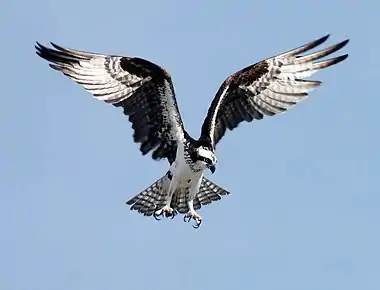
Order: Accipitriformes Family: Pandionidae
The family Pandionidae contains only one species, the osprey. The osprey is a medium-large raptor which is a specialist fish-eater with a worldwide distribution.
- Osprey, Pandion haliaetus
Hawks, eagles, and kites

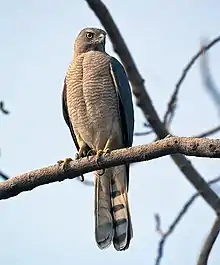
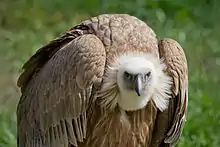
Order: Accipitriformes Family: Accipitridae
Accipitridae is a family of birds of prey, which includes hawks, eagles, kites, harriers and Old World vultures. These birds have powerful hooked beaks for tearing flesh from their prey, strong legs, powerful talons and keen eyesight.
- Black-winged kite, Elanus caeruleus
- Bearded vulture, Gypaetus barbatus
- Egyptian vulture, Neophron percnopterus
- European honey-buzzard, Pernis apivorus (A)
- Oriental honey-buzzard, Pernis ptilorhynchus
- Cinereous vulture, Aegypius monachus
- White-rumped vulture, Gyps bengalensis (A)
- Himalayan griffon, Gyps himalayensis
- Eurasian griffon, Gyps fulvus
- Short-toed snake-eagle, Circaetus gallicus
- Greater spotted eagle, Clanga clanga
- Booted eagle, Hieraaetus pennatus
- Tawny eagle, Aquila rapax (A)
- Steppe eagle, Aquila nipalensis
- Imperial eagle, Aquila heliaca
- Golden eagle, Aquila chrysaetos
- Bonelli's eagle, Aquila fasciata (A)
- White-eyed buzzard, Butastur teesa (A)
- Eurasian marsh-harrier, Circus aeruginosus
- Hen harrier, Circus cyaneus
- Pallid harrier, Circus macrourus
- Montagu's harrier, Circus pygargus
- Shikra, Accipiter badius
- Levant sparrowhawk, Accipiter brevipes (A)
- Eurasian sparrowhawk, Accipiter nisus
- Northern goshawk, Accipiter gentilis
- Black kite, Milvus migrans
- White-tailed eagle, Haliaeetus albicilla
- Pallas's fish-eagle, Haliaeetus leucoryphus
- Rough-legged hawk, Buteo lagopus
- Common buzzard, Buteo buteo
- Long-legged buzzard, Buteo rufinus
Barn-owls
.jpg.webp)
Order: Strigiformes Family: Tytonidae
Barn owls are medium to large owls with large heads and characteristic heart-shaped faces. They have long strong legs with powerful talons.
- Barn owl, Tyto alba (A)
Owls

Order: Strigiformes Family: Strigidae
The typical owls are small to large solitary nocturnal birds of prey. They have large forward-facing eyes and ears, a hawk-like beak and a conspicuous circle of feathers around each eye called a facial disk.
- Indian scops-owl, Otus bakkamoena
- Eurasian scops-owl, Otus scops
- Pallid scops-owl, Otus brucei (A)
- Eurasian eagle-owl, Bubo bubo
- Collared owlet, Taenioptynx brodiei
- Little owl, Athene noctua
- Tawny owl, Strix aluco
- Long-eared owl, Asio otus
- Short-eared owl, Asio flammeus
- Boreal owl, Aegolius funereus (A)
Hoopoes
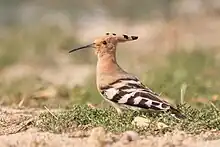
Order: Bucerotiformes Family: Upupidae
Hoopoes have black, white and orangey-pink colouring with a large erectile crest on their head.
- Eurasian hoopoe, Upupa epops
Kingfishers
_female.jpg.webp)
Order: Coraciiformes Family: Alcedinidae
Kingfishers are medium-sized birds with large heads, long, pointed bills, short legs and stubby tails.
- Common kingfisher, Alcedo atthis
- White-throated kingfisher, Halcyon smyrnensis
- Crested kingfisher, Megaceryle lugubris
- Pied kingfisher, Ceryle rudis
Bee-eaters
_Namibia.jpg.webp)
Order: Coraciiformes Family: Meropidae
The bee-eaters are a group of near passerine birds in the family Meropidae. Most species are found in Africa but others occur in southern Europe, Madagascar, Australia and New Guinea. They are characterised by richly coloured plumage, slender bodies and usually elongated central tail feathers. All are colourful and have long downturned bills and pointed wings, which give them a swallow-like appearance when seen from afar.
- Blue-cheeked bee-eater, Merops persicus
- European bee-eater, Merops apiaster
Rollers
Order: Coraciiformes Family: Coraciidae
Rollers resemble crows in size and build, but are more closely related to the kingfishers and bee-eaters. They share the colourful appearance of those groups with blues and browns predominating. The two inner front toes are connected, but the outer toe is not.
- European roller, Coracias garrulus
- Indian roller, Coracias benghalensis
Woodpeckers

Order: Piciformes Family: Picidae
Woodpeckers are small to medium-sized birds with chisel-like beaks, short legs, stiff tails and long tongues used for capturing insects. Some species have feet with two toes pointing forward and two backward, while several species have only three toes. Many woodpeckers have the habit of tapping noisily on tree trunks with their beaks.
- Eurasian wryneck, Jynx torquilla
- Speckled piculet, Picumnus innominatus
- Brown-fronted woodpecker, Dendrocoptes auriceps
- White-winged woodpecker, Dendrocopos leucopterus
- Himalayan woodpecker, Dendrocopos himalayensis
- Scaly-bellied woodpecker, Picus squamatus
Falcons and caracaras
.jpg.webp)
Order: Falconiformes Family: Falconidae
Falconidae is a family of diurnal birds of prey. They differ from hawks, eagles and kites in that they kill with their beaks instead of their talons.
- Lesser kestrel, Falco naumanni
- Eurasian kestrel, Falco tinnunculus
- Red-footed falcon, Falco vespertinus
- Merlin, Falco columbarius
- Eurasian hobby, Falco subbuteo
- Laggar falcon, Falco jugger
- Saker falcon, Falco cherrug
- Gyrfalcon, Falco rusticolus (A)
- Peregrine falcon, Falco peregrinus
Old World parrots
.jpg.webp)
Order: Psittaciformes Family: Psittaculidae
Old World parrots are small to large birds with a characteristic curved beak. Their upper mandibles have slight mobility in the joint with the skull and they have a generally erect stance. All parrots are zygodactyl, having the four toes on each foot placed two at the front and two to the back.
- Alexandrine parakeet, Psittacula eupatria (A)
- Rose-ringed parakeet, Psittacula krameri (I)
- Slaty-headed parakeet, Psittacula himalayana
Cuckooshrikes
.jpg.webp)
Order: Passeriformes Family: Campephagidae
The cuckooshrikes are small to medium-sized passerine birds. They are predominantly greyish with white and black, although some species are brightly coloured.
- Long-tailed minivet, Pericrocotus ethologus
- Rosy minivet, Pericrocotus roseus (A)
Old World orioles
Order: Passeriformes Family: Oriolidae
The Old World orioles are colourful passerine birds. They are not related to the New World orioles.
- Eurasian golden oriole, Oriolus oriolus
- Indian golden oriole, Oriolus kundoo
Drongos
_IMG_7702_(1)..JPG.webp)
Order: Passeriformes Family: Dicruridae
The drongos are mostly black or dark grey in colour, sometimes with metallic tints. They have long forked tails, and some Asian species have elaborate tail decorations. They have short legs and sit very upright when perched, like a shrike. They flycatch or take prey from the ground.
- Black drongo, Dicrurus macrocercus
- Ashy drongo, Dicrurus leucophaeus
Monarch flycatchers
Order: Passeriformes Family: Monarchidae
The monarch flycatchers are small to medium-sized insectivorous passerines which hunt by flycatching.
- Indian paradise-flycatcher, Terpsiphone paradisi
Shrikes
.jpg.webp)
Order: Passeriformes Family: Laniidae
Shrikes are passerine birds known for their habit of catching other birds and small animals and impaling the uneaten portions of their bodies on thorns. A typical shrike's beak is hooked, like a bird of prey.
- Red-backed shrike, Lanius collurio (A)
- Red-tailed shrike, Lanius phoenicuroides
- Isabelline shrike, Lanius isabellinus
- Brown shrike, Lanius cristatus (A)
- Bay-backed shrike, Lanius vittatus
- Long-tailed shrike, Lanius schach
- Great gray shrike, Lanius excubitor
- Lesser gray shrike, Lanius minor
- Woodchat shrike, Lanius senator (A)
Crows, jays, and magpies
%252C_%D0%9A%D0%B0%D0%BB%D0%B8%D0%BD%D0%B8%D0%BD%D0%B3%D1%80%D0%B0%D0%B4.jpg.webp)
_(37750869326).jpg.webp)
Order: Passeriformes Family: Corvidae
The family Corvidae includes crows, ravens, jays, choughs, magpies, treepies, nutcrackers and ground jays. Corvids are above average in size among the Passeriformes, and some of the larger species show high levels of intelligence.
- Black-headed jay, Garrulus lanceolatus
- Eurasian magpie, Pica pica
- Eurasian nutcracker, Nucifraga caryocatactes
- Kashmir nutcracker, Nucifraga multipunctata
- Red-billed chough, Pyrrhocorax pyrrhocorax
- Yellow-billed chough, Pyrrhocorax graculus
- Eurasian jackdaw, Corvus monedula
- House crow, Corvus splendens (A)
- Rook, Corvus frugilegus
- Carrion crow, Corvus corone
- Hooded crow, Corvus cornix
- Large-billed crow, Corvus macrorhynchos
- Brown-necked raven, Corvus ruficollis
- Common raven, Corvus corax
Tits, chickadees, and titmice
_(15275201963).jpg.webp)
Order: Passeriformes Family: Paridae
The Paridae are mainly small stocky woodland species with short stout bills. Some have crests. They are adaptable birds, with a mixed diet including seeds and insects.
- Coal tit, Periparus ater
- Rufous-naped tit, Periparus rufonuchalis
- Azure tit, Cyanistes cyanus
- Ground tit, Pseudopodoces humilis
- Great tit, Parus major
- Cinereous tit, Parus cinereus
Penduline-tits
.jpg.webp)
Order: Passeriformes Family: Remizidae
The penduline-tits are a group of small passerine birds related to the true tits. They are insectivores.
- Eurasian penduline-tit, Remiz pendulinus
- Black-headed penduline-tit, Remiz macronyx
- White-crowned penduline-tit, Remiz coronatus
Larks

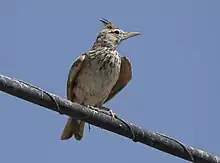
Order: Passeriformes Family: Alaudidae
Larks are small terrestrial birds with often extravagant songs and display flights. Most larks are fairly dull in appearance. Their food is insects and seeds.
- Greater hoopoe-lark, Alaemon alaudipes
- Bar-tailed lark, Ammomanes cincturus
- Desert lark, Ammomanes deserti
- Horned lark, Eremophila alpestris
- Greater short-toed lark, Calandrella brachydactyla
- Hume's lark, Calandrella acutirostris
- Bimaculated lark, Melanocorypha bimaculata
- Calandra lark, Melanocorypha calandra
- Turkestan short-toed lark, Alaudala heinei
- Sand lark, Alaudala raytal (A)
- Wood lark, Lullula arborea (A)
- Eurasian skylark, Alauda arvensis
- Oriental skylark, Alauda gulgula
- Crested lark, Galerida cristata
Bearded reedling
Order: Passeriformes Family: Panuridae
This species, the only one in its family, is found in reed beds throughout temperate Europe and Asia.
- Bearded reedling, Panurus biarmicus
Cisticolas and allies
.jpg.webp)
Order: Passeriformes Family: Cisticolidae
The Cisticolidae are warblers found mainly in warmer southern regions of the Old World. They are generally very small birds of drab brown or grey appearance found in open country such as grassland or scrub.
- Himalayan prinia, Prinia crinigera
- Delicate prinia, Prinia lepida
- Plain prinia, Prinia inornata (A)
- Zitting cisticola, Cisticola juncidis
Reed warblers and allies
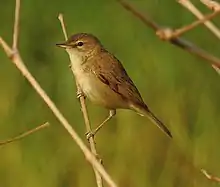
Order: Passeriformes Family: Acrocephalidae
The members of this family are usually rather large for "warblers". Most are rather plain olivaceous brown above with much yellow to beige below. They are usually found in open woodland, reedbeds, or tall grass. The family occurs mostly in southern to western Eurasia and surroundings, but it also ranges far into the Pacific, with some species in Africa.
- Booted warbler, Iduna caligata
- Sykes's warbler, Iduna rama
- Eastern olivaceous warbler, Iduna pallida (A)
- Upcher's warbler, Hippolais languida
- Moustached warbler, Acrocephalus melanopogon
- Paddyfield warbler, Acrocephalus agricola
- Blunt-winged warbler, Acrocephalus concinens
- Blyth's reed warbler, Acrocephalus dumetorum
- Large-billed reed warbler, Acrocephalus orinus
- Eurasian reed warbler, Acrocephalus scirpaceus
- Great reed warbler, Acrocephalus arundinaceus
- Clamorous reed warbler, Acrocephalus stentoreus
Grassbirds and allies
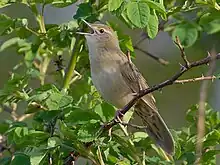
Order: Passeriformes Family: Locustellidae
Locustellidae are a family of small insectivorous songbirds found mainly in Eurasia, Africa, and the Australian region. They are smallish birds with tails that are usually long and pointed, and tend to be drab brownish or buffy all over.
- Common grasshopper-warbler, Locustella naevia
Swallows
_(32682255041).jpg.webp)
Order: Passeriformes Family: Hirundinidae
The family Hirundinidae is adapted to aerial feeding. They have a slender streamlined body, long pointed wings and a short bill with a wide gape. The feet are adapted to perching rather than walking, and the front toes are partially joined at the base.
- Gray-throated martin, Riparia chinensis
- Bank swallow, Riparia riparia
- Pale sand martin, Riparia diluta
- Eurasian crag-martin, Ptyonoprogne rupestris
- Rock martin, Ptyonoprogne fuligula
- Barn swallow, Hirundo rustica
- Wire-tailed swallow, Hirundo smithii
- Red-rumped swallow, Cecropis daurica
- Streak-throated swallow, Petrochelidon fluvicola
- Common house-martin, Delichon urbicum
- Asian house-martin, Delichon dasypus
Bulbuls
_in_Tirunelveli%252C_India.jpg.webp)
Order: Passeriformes Family: Pycnonotidae
Bulbuls are medium-sized songbirds. Some are colourful with yellow, red or orange vents, cheeks, throats or supercilia, but most are drab, with uniform olive-brown to black plumage. Some species have distinct crests.
- Red-vented bulbul, Pycnonotus cafer
- White-eared bulbul, Pycnonotus leucotis
- Himalayan bulbul, Pycnonotus leucogenys
- Black bulbul, Hypsipetes leucocephalus
Leaf warblers
_(2)_(cropped).jpg.webp)
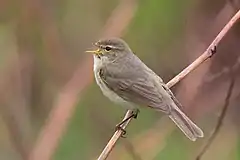
Order: Passeriformes Family: Phylloscopidae
Leaf warblers are a family of small insectivorous birds found mostly in Eurasia and ranging into Wallacea and Africa. The species are of various sizes, often green-plumaged above and yellow below, or more subdued with grayish-green to grayish-brown colors.
- Wood warbler, Phylloscopus sibilatrix (A)
- Hume's warbler, Phylloscopus humei
- Brooks's leaf warbler, Phylloscopus subviridis
- Pallas's leaf warbler, Phylloscopus proregulus
- Lemon-rumped warbler, Phylloscopus chloronotus
- Tytler's leaf warbler, Phylloscopus tytleri
- Radde's warbler, Phylloscopus schwarzi
- Sulphur-bellied warbler, Phylloscopus griseolus
- Plain leaf warbler, Phylloscopus neglectus
- Willow warbler, Phylloscopus trochilus
- Mountain chiffchaff, Phylloscopus sindianus
- Common chiffchaff, Phylloscopus collybita
- Green warbler, Phylloscopus nitidus
- Greenish warbler, Phylloscopus trochiloides
- Arctic warbler, Phylloscopus borealis (A)
- Western crowned warbler, Phylloscopus occipitalis
Bush warblers and allies
_(cropped).jpg.webp)
Order: Passeriformes Family: Scotocercidae
The members of this family are found throughout Africa, Asia, and Polynesia. Their taxonomy is in flux, and some authorities place some genera in other families.[2]
- Scrub warbler, Scotocerca inquieta
- Cetti's warbler, Cettia cetti
Long-tailed tits
Order: Passeriformes Family: Aegithalidae
Long-tailed tits are a group of small passerine birds with medium to long tails. They make woven bag nests in trees. Most eat a mixed diet which includes insects.
- White-cheeked tit, Aegithalos leucogenys
Sylviid warblers, parrotbills, and allies
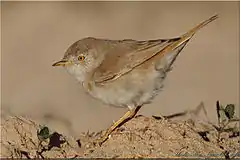
Order: Passeriformes Family: Sylviidae
The family Sylviidae is a group of small insectivorous passerine birds. They mainly occur as breeding species, as the common name implies, in Europe, Asia and, to a lesser extent, Africa. Most are of generally undistinguished appearance, but many have distinctive songs.
- Garden warbler, Sylvia borin (A)
- Asian desert warbler, Curruca nana
- Barred warbler, Curruca nisoria (A)
- Lesser whitethroat, Curruca curruca
- Eastern Orphean warbler, Curruca crassirostris
- Menetries's warbler, Curruca mystacea
- Greater whitethroat, Curruca communis
White-eyes, yuhinas, and allies
Order: Passeriformes Family: Zosteropidae
The white-eyes are small and mostly undistinguished, their plumage above being generally some dull colour like greenish-olive, but some species have a white or bright yellow throat, breast or lower parts, and several have buff flanks. As their name suggests, many species have a white ring around each eye.
- Indian white-eye, Zosterops palpebrosus
Laughingthrushes
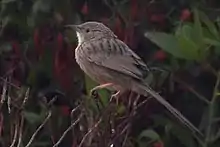
Order: Passeriformes Family: Leiothrichidae
The members of this family are diverse in size and coloration, though those of genus Turdoides tend to be brown or grayish. The family is found in Africa, India, and southeast Asia.
- Afghan babbler, Argya huttoni
- Common babbler, Argya caudata (A)
- Streaked laughingthrush, Trochalopteron lineatus
- Variegated laughingthrush, Trochalopteron variegatus
Kinglets
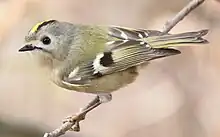
Order: Passeriformes Family: Regulidae
The kinglets, also called crests, are a small group of birds often included in the Old World warblers, but frequently given family status because they also resemble the titmice.
- Goldcrest, Regulus regulus
Wallcreeper
Order: Passeriformes Family: Tichodromidae
The wallcreeper is a small bird related to the nuthatch family, which has stunning crimson, grey and black plumage.
- Wallcreeper, Tichodroma muraria
Nuthatches
_(47088107744)_(cropped).jpg.webp)
Order: Passeriformes Family: Sittidae
Nuthatches are small woodland birds. They have the unusual ability to climb down trees head first, unlike other birds which can only go upwards. Nuthatches have big heads, short tails and powerful bills and feet.
- Eurasian nuthatch, Sitta europaea
- Kashmir nuthatch, Sitta cashmirensis
- White-cheeked nuthatch, Sitta leucopsis
- Eastern rock nuthatch, Sitta tephronota
Treecreepers

Order: Passeriformes Family: Certhiidae
Treecreepers are small woodland birds, brown above and white below. They have thin pointed down-curved bills, which they use to extricate insects from bark. They have stiff tail feathers, like woodpeckers, which they use to support themselves on vertical trees.
- Bar-tailed treecreeper, Certhia himalayana
Wrens
Order: Passeriformes Family: Troglodytidae
The wrens are mainly small and inconspicuous except for their loud songs. These birds have short wings and thin down-turned bills. Several species often hold their tails upright. All are insectivorous.
- Eurasian wren, Troglodytes troglodytes
Dippers
.JPG.webp)
Order: Passeriformes Family: Cinclidae
Dippers are a group of perching birds whose habitat includes aquatic environments in the Americas, Europe and Asia. They are named for their bobbing or dipping movements.
- White-throated dipper, Cinclus cinclus
- Brown dipper, Cinclus pallasii
Starlings
_male.jpg.webp)
Order: Passeriformes Family: Sturnidae
Starlings are small to medium-sized passerine birds. Their flight is strong and direct and they are very gregarious. Their preferred habitat is fairly open country. They eat insects and fruit. Plumage is typically dark with a metallic sheen.
- European starling, Sturnus vulgaris
- Rosy starling, Pastor roseus
- Brahminy starling, Sturnia pagodarum
- Common myna, Acridotheres tristis
- Bank myna, Acridotheres ginginianus (A)
Thrushes and allies
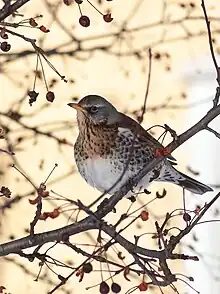
Order: Passeriformes Family: Turdidae
The thrushes are a group of passerine birds that occur mainly in the Old World. They are plump, soft plumaged, small to medium-sized insectivores or sometimes omnivores, often feeding on the ground. Many have attractive songs.
- Mistle thrush, Turdus viscivorus
- Redwing, Turdus iliacus
- Eurasian blackbird, Turdus merula
- Tickell's thrush, Turdus unicolor
- Fieldfare, Turdus pilaris (A)
- Chestnut thrush, Turdus rubrocanus
- Black-throated thrush, Turdus atrogularis
- Red-throated thrush, Turdus ruficollis (A)
Old World flycatchers
_Uganda.jpg.webp)
_(48051377556).jpg.webp)
_(8079431820).jpg.webp)
Order: Passeriformes Family: Muscicapidae
Old World flycatchers are a large group of small passerine birds native to the Old World. They are mainly small arboreal insectivores. The appearance of these birds is highly varied, but they mostly have weak songs and harsh calls.
- Dark-sided flycatcher, Muscicapa sibirica
- Spotted flycatcher, Muscicapa striata
- Rufous-tailed scrub-robin, Cercotrichas galactotes
- Indian robin, Copsychus fulicatus (A)
- Oriental magpie-robin, Copsychus saularis (A)
- European robin, Erithacus rubecula (A)
- Indian blue robin, Larvivora brunnea
- White-throated robin, Irania gutturalis
- Thrush nightingale, Luscinia luscinia (A)
- Common nightingale, Luscinia megarhynchos
- Bluethroat, Luscinia svecica
- Blue whistling-thrush, Myophonus caeruleus
- Little forktail, Enicurus scouleri
- Spotted forktail, Enicurus maculatus
- Siberian rubythroat, Calliope calliope (A)
- Himalayan rubythroat, Calliope pectoralis
- Himalayan bluetail, Tarsiger rufilatus
- Ultramarine flycatcher, Ficedula superciliaris
- Rusty-tailed flycatcher, Ficedula ruficauda
- Taiga flycatcher, Ficedula albicilla
- Red-breasted flycatcher, Ficedula parva
- European pied flycatcher, Ficedula hypoleuca (A)
- Blue-fronted redstart, Phoenicurus frontalis
- Plumbeous redstart, Phoenicurus fuliginosus
- Rufous-backed redstart, Phoenicurus erythronota
- White-capped redstart, Phoenicurus leucocephalus
- Blue-capped redstart, Phoenicurus caeruleocephalus
- Common redstart, Phoenicurus phoenicurus
- White-winged redstart, Phoenicurus erythrogaster
- Black redstart, Phoenicurus ochruros
- Blue-capped rock-thrush, Monticola cinclorhyncha
- Rufous-tailed rock-thrush, Monticola saxatilis
- Blue rock-thrush, Monticola solitarius
- Whinchat, Saxicola rubetra (A)
- White-browed bushchat, Saxicola macrorhynchus (A)
- Siberian stonechat, Saxicola maurus
- Pied bushchat, Saxicola caprata
- Northern wheatear, Oenanthe oenanthe
- Isabelline wheatear, Oenanthe isabellina
- Hooded wheatear, Oenanthe monacha
- Desert wheatear, Oenanthe deserti
- Pied wheatear, Oenanthe pleschanka
- Variable wheatear, Oenanthe picata
- Hume's wheatear, Oenanthe alboniger
- Finsch's wheatear, Oenanthe finschii
- Persian wheatear, Oenanthe chrysopygia
Hypocolius
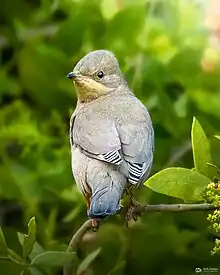
Order: Passeriformes Family: Hypocoliidae
The grey hypocolius is a small Middle Eastern bird with the shape and soft plumage of a waxwing. They are mainly a uniform grey colour except the males have a black triangular mask around their eyes.
- Hypocolius, Hypocolius ampelinus
Sunbirds and spiderhunters
Order: Passeriformes Family: Nectariniidae
The sunbirds and spiderhunters are very small passerine birds which feed largely on nectar, although they will also take insects, especially when feeding young. Flight is fast and direct on their short wings. Most species can take nectar by hovering like a hummingbird, but usually perch to feed.
- Purple sunbird, Cinnyris asiaticus
Waxbills and allies
_Photograph_by_Shantanu_Kuveskar.jpg.webp)
Order: Passeriformes Family: Estrildidae
The estrildid finches are small passerine birds of the Old World tropics and Australasia. They are gregarious and often colonial seed eaters with short thick but pointed bills. They are all similar in structure and habits, but have wide variation in plumage colours and patterns.
- Red avadavat, Amandava amandava (I)
- Scaly-breasted munia, Lonchura punctulata (I)
Accentors
_(42901525014).jpg.webp)
Order: Passeriformes Family: Prunellidae
The accentors are in the only bird family, Prunellidae, which is completely endemic to the Palearctic. They are small, fairly drab species superficially similar to sparrows.
- Alpine accentor, Prunella collaris
- Altai accentor, Prunella himalayana
- Rufous-breasted accentor, Prunella strophiata
- Radde's accentor, Prunella ocularis (A)
- Brown accentor, Prunella fulvescens
- Black-throated accentor, Prunella atrogularis
- Dunnock, Prunella modularis
Old World sparrows
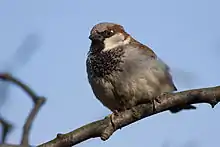
Order: Passeriformes Family: Passeridae
Old World sparrows are small passerine birds. In general, sparrows tend to be small, plump, brown or grey birds with short tails and short powerful beaks. Sparrows are seed eaters, but they also consume small insects.
- Saxaul sparrow, Passer ammodendri (A)
- House sparrow, Passer domesticus
- Spanish sparrow, Passer hispaniolensis
- Russet sparrow, Passer cinnamomeus
- Dead Sea sparrow, Passer moabiticus
- Eurasian tree sparrow, Passer montanus
- Yellow-throated sparrow, Gymnoris xanthocollis
- Rock sparrow, Petronia petronia
- Pale rockfinch, Carpospiza brachydactyla (A)
- White-winged snowfinch, Montifringilla nivalis
- Afghan snowfinch, Montifringilla theresae
Wagtails and pipits
_(35825769583).jpg.webp)
Order: Passeriformes Family: Motacillidae
Motacillidae is a family of small passerine birds with medium to long tails. They include the wagtails, longclaws and pipits. They are slender, ground feeding insectivores of open country.
- Gray wagtail, Motacilla cinerea
- Western yellow wagtail, Motacilla flava
- Citrine wagtail, Motacilla citreola
- White-browed wagtail, Motacilla maderaspatensis
- White wagtail, Motacilla alba
- Richard's pipit, Anthus richardi
- Paddyfield pipit, Anthus rufulus
- Long-billed pipit, Anthus similis
- Tawny pipit, Anthus campestris
- Upland pipit, Anthus sylvanus
- Meadow pipit, Anthus pratensis (A)
- Rosy pipit, Anthus roseatus
- Tree pipit, Anthus trivialis
- Olive-backed pipit, Anthus hodgsoni
- Red-throated pipit, Anthus cervinus
- Water pipit, Anthus spinoletta
- American pipit, Anthus rubescens (A)
Finches, euphonias, and allies
Order: Passeriformes Family: Fringillidae
_-_48739617622.jpg.webp)
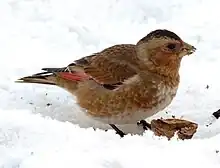
Finches are seed-eating passerine birds, that are small to moderately large and have a strong beak, usually conical and in some species very large. All have twelve tail feathers and nine primaries. These birds have a bouncing flight with alternating bouts of flapping and gliding on closed wings, and most sing well.
- Common chaffinch, Fringilla coelebs
- Brambling, Fringilla montifringilla
- Black-and-yellow grosbeak, Mycerobas icterioides (A)
- White-winged grosbeak, Mycerobas carnipes
- Hawfinch, Coccothraustes coccothraustes
- Common rosefinch, Carpodacus erythrinus
- Blyth's rosefinch, Carpodacus grandis
- Pale rosefinch, Carpodacus stoliczkae
- Great rosefinch, Carpodacus rubicilla
- Himalayan white-browed rosefinch, Carpodacus thura
- Eurasian bullfinch, Pyrrhula pyrrhula
- Crimson-winged finch, Rhodopechys sanguineus
- Trumpeter finch, Bucanetes githagineus
- Mongolian finch, Bucanetes mongolicus
- Plain mountain finch, Leucosticte nemoricola
- Black-headed mountain finch, Leucosticte brandti
- Desert finch, Rhodospiza obsoleta
- European greenfinch, Chloris chloris
- Twite, Linaria flavirostris
- Eurasian linnet, Linaria cannabina
- Red crossbill, Loxia curvirostra (A)
- European goldfinch, Carduelis carduelis
- Fire-fronted serin, Serinus pusillus
- Eurasian siskin, Spinus spinus (A)
Old World buntings
Order: Passeriformes Family: Emberizidae
.jpg.webp)
The emberizids are a large family of passerine birds. They are seed-eating birds with distinctively shaped bills. Many emberizid species have distinctive head patterns.
- Black-headed bunting, Emberiza melanocephala (A)
- Red-headed bunting, Emberiza bruniceps
- Corn bunting, Emberiza calandra
- Chestnut-eared bunting, Emberiza fucata (A)
- Rock bunting, Emberiza cia
- White-capped bunting, Emberiza stewarti
- Yellowhammer, Emberiza citrinella (A)
- Pine bunting, Emberiza leucocephalos
- Gray-necked bunting, Emberiza buchanani
- Ortolan bunting, Emberiza hortulana
- Striolated bunting, Emberiza striolata
- Reed bunting, Emberiza schoeniclus
- Little bunting, Emberiza pusilla
- Rustic bunting, Emberiza rustica
See also
References
- ↑ BirdLife International. (2018). "Leucogeranus leucogeranus". IUCN Red List of Threatened Species. 2018: e.T22692053A134180990. doi:10.2305/IUCN.UK.2018-2.RLTS.T22692053A134180990.en. Retrieved 3 April 2021.
- ↑ Gill, F. and D. Donsker (Eds). 2019. IOC World Bird List (v 9.2). doi:10.14344/IOC.ML.9.2. http://www.worldbirdnames.org/ retrieved 22 June 2019.
- Lepage, Denis. "Checklist of Birds of Afghanistan". Bird Checklists of the World. Avibase. Retrieved 27 April 2020.
- Clements, James F. (2000). Birds of the World: A Checklist. Cornell University Press. p. 880. ISBN 0-934797-16-1.